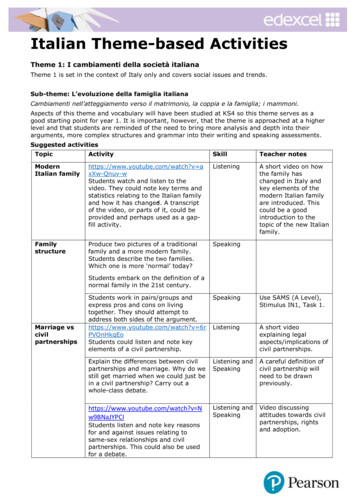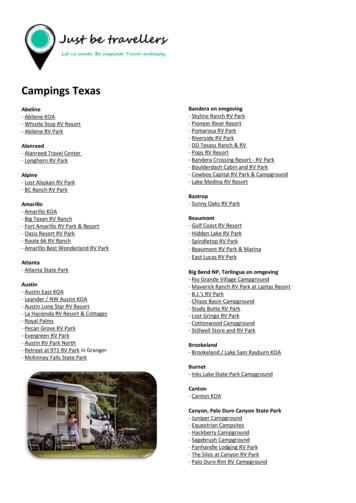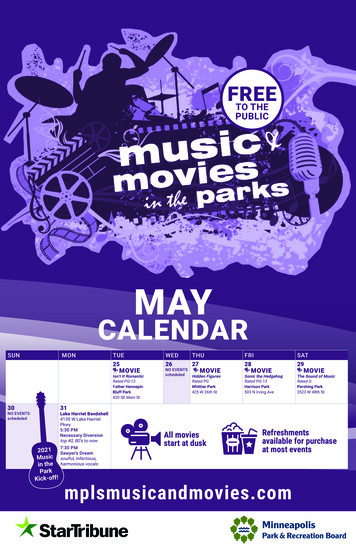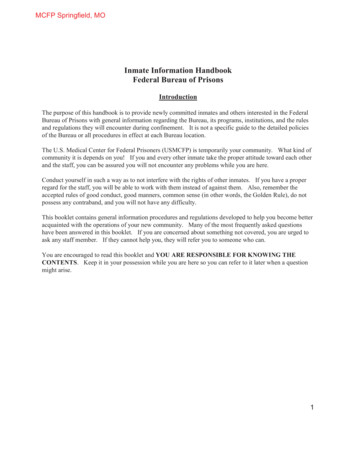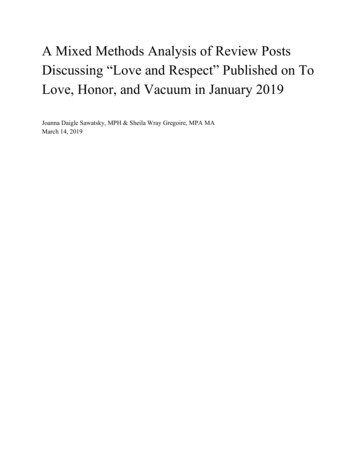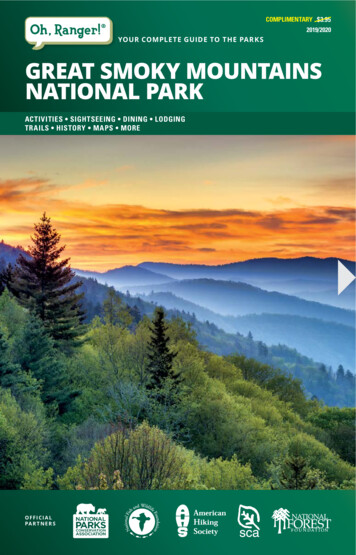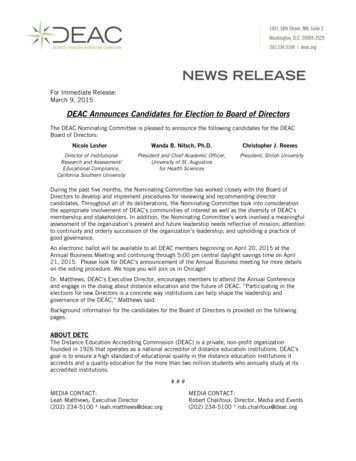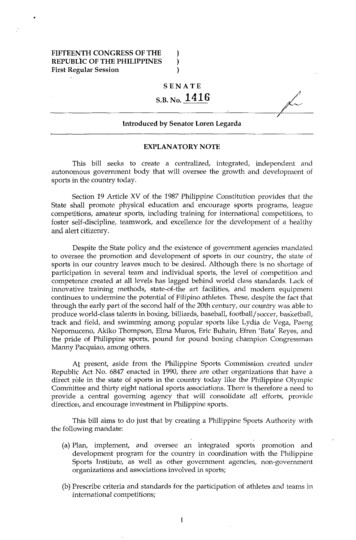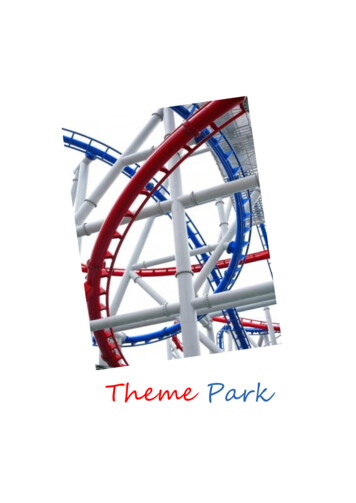
Transcription
Theme Parki
ii
ContributorsSchool of Hotel and Tourism Management,The Hong Kong Polytechnic UniversityandPSHE Section, Curriculum Development Instituteiii
iv
Copyright The Government of the Hong Kong Special Administrative RegionAll rights reserved.The copyright of this manual belongs to the Government of the Hong Kong SpecialAdministrative Region. Commercial use is strictly prohibited. Offenders will be liable to legalresponsibility.Schools need not apply for permission to copy this manual in whole or in part for non-profitmaking educational or research purposes. All other uses should gain prior permission inwriting from the Government of the Hong Kong Special Administrative Region. Requestsshould be directed to the:Education Bureau13/F, Room 1319, Wu Chung House213 Queen’s Road East,Wan ChaiHong Kongorby email to: info pshe@edb.gov.hkv
Acknowledgement1."Clapperboard" courtesy of digitalart. Published on 20 April 2011. Stock photo - Image ID:10038511 at FreeDigitalPhotos.net2."Jupiter And The Satellite" courtesy of njaj. Published on 3 December 2014. Stock photo Image ID: 100300238 at FreeDigitalPhotos.net3."Line Of Roller Coaster Rail" courtesy of antpkr. Published Photo by antpkr. Published on 12October 2012 Stock photo - Image ID: 100106338 at FreeDigitalPhotos.net4."Mascot Cartoon" courtesy of woravit.w. Published on 25 February 2015. Stock photo Image ID: 100312445 at FreeDigitalPhotos.net5."Paper Weather Icon" courtesy of SweetCrisis. Published on 13 February 2013. Stock photo- Image ID: 100139301 at FreeDigitalPhotos.net6."Recycle Icon" courtesy of digitalart. Published on 24 July 2011. Stock photo - Image ID:10051023 at FreeDigitalPhotos.net7."Roller Coaster Rail" courtesy of antpkr. Published Photo by antpkr. Published on 13December 2012 Stock photo - Image ID: 100126980 at FreeDigitalPhotos.net (front cover)8."Target Audience" courtesy of sheelamohan. Published on 19 April 2011. Stock photo Image ID: 10038289 at FreeDigitalPhotos.net9."Travel Flat Icon.Hotel" courtesy of Sira Anamwong. Published on 13 August 2015. Stockphoto - Image ID: 100351018 at FreeDigitalPhotos.net10. "Travel Flat Icon.Map" courtesy of Sira Anamwong. Published on 13 August 2015. Stockphoto - Image ID: 100351019 at FreeDigitalPhotos.netvi
Module III - Destination GeographyTheme Parkvii
Contents1. The fundamental concepts of theme parks1.1 Types of theme park1.2 The features of a theme parkPage1012172. Factors contributing to the success of theme parks2.1 Overall attractiveness and visitors’ experiences(I) Unique and interesting theme(II) Value for money / Variety of on-site attractions(III) Clean and pleasant environment(IV) Motivated and well-trained staff(V) Good location(VI) Quality and consistency in services and facilities2.2 Adapt to market changes(I) Senior segment(II) Environmentally-friendly(III) ‘Edutainment’(IV) Interactive experiences2.3 The management(I) Pro-active management(II) Strong financial resources and on-going investment(III) Strong marketing team(IV) ks40References45viii
ix
1. The Fundamental Concepts of Theme ParksGenerally speaking, theme parks can be defined as a subset of visitor attractions(Goeldner, 1999).Although theme park is asubset of visitor attractions,there are attributes thatdistinguish theme park fromother kinds of visitorattractions in particular theentertainment attractions(Kemperman, 2000). Theattributes are:(i)pay-one-price admission charge or pay-one-price attractions ( **admissioncharge for amusement parks is usually very minimal, and generally adopted apay-as-you-go attractions pricing structure );(ii)attractions are mostly man-made;(iii)high capital investments (Kemperman, 2000) ; and(iv) a combination of entertainment, food and beverage outlets, shops, and anenvironment that is different from that found outside its gates.DefinitionsIn view of the above unique attributes, definitions of theme park written by thetourism industry and academic are presented:Industry’s definition of a theme park:1. According to the International Association of Amusement Parks andAttractions (IAAPA), a theme park is ‘an amusement park that has themed10
attractions, be it food, costumes, entertainment, retail stores and/or rides’(IAAPA).2. According to Forrec, the theme park is a place of escape – a chance to stepaway from the big burdens of the everyday. (Forrec, 2015)Academic definition of a theme park:1. Theme park as an aggregation of themed attractions, including architecture,landscape, rides, shows, foodservices, costumed personnel, and retail shops(Heo, 2009).2. Theme parks are extreme examples of capital intensive, highly developed,user-oriented, man modified, recreational environments (Pearce, 1988).3. A theme park is a destination in its own right, which combines entertainment,food and beverage and shops, and an environment that is different from thatfound outside its gates (Ap and Ho, 2009).Despite a number of different definitions of theme park are presented, a commonattribute is shared among them. Theme parks, in general, apply themes to providevisitors with interesting experiences different from daily life (Heo, 2009).11
1.1 Types of theme parkThe theme is the main part of the visitors’ experience which is chosen when thepark is planned to provide a focus for the design, development and operation ofsuch a park. Therefore, the selection of the theme is extremely important to theoperations of the park. In general, theme parks attempt to create an atmosphere ofanother place and time, and usually emphasize one dominant theme around whicharchitecture, landscape, rides, shows, food services, costumed personnel, retailingare orchestrated (Kemperman, 2000).Although theme parks were thought of offering visitors one major theme, todaymost of the theme parks contain multi-themes in terms of different attraction pointsor themed areas (Wong & Cheung, 1999). For example, Ocean Park Hong Kongmajor theme is nature but it has multi-themes including wildlife animals and marinelife.Theme parks can generally be classified into seven theme types and relatedattributes as follows:Type of theme park1. AdventureAttributes Excitement and actionFrighteningMysteriousThrill rides12
Type of theme parkAttributes2. Futurism Advances in society and technologyDiscoveryExploration of science and technologyRoboticsScientificScience fiction3. International Flavours of the worldInternational villageMiniature replicasScenic spotsWorld expositions4. Nature AnimalsFloral displaysHorticultural gardensLandscapingMarine lifeNatural wondersOceanWildlife5. AnimationCartoon charactersChildhood enchantmentChildren’s play parkFairy talesMagicMake believeMyths and legendsFantasy13
Type of theme parkAttributes6. History and culture AboriginalAuthenticCultural heritageCultural villageGold rushHistoric ambience7. American Wild West showsComedyMotion picturesShow businessStunt showsMoviesTypes of theme park(Source: Wong & Cheung, 1999)14
Discussion Questions1.Link to the website of TEA - Themed Entertainment TEA 235 103719 170601.pdf , and using theinformation to give two examples for each types of theme park listed in thebelow table:Type of theme parkExamples1. Adventure2. Futurism3. International4. Nature5. Fantasy6. History and culture7. Movies15
2. Refer to “Photo A” and “Photo B” below:How are the two pricing structures different from each other?16
1.2 The Features of a Theme ParkAccording to Kotler and Swarbrooke, there are three levels of product in a themepark, and each level has its own features: Level 1: Core product;Level 2: Supporting (Tangible) product; andLevel 3: Facilitating (Augmented) product.In fact, visitors visit a theme park for an expectation of a wonderful experience thatcombines all the features from the three levels of product.(Source: Kotler,1994; Swarbrooke,1995)17
Level 1: The Core ProductThe core product is the most fundamental level andis what the visitor is really buying. The productconsists of benefits sought by the visitors but theyare intangible in nature, such as: ExcitementAtmosphereFunValue for money / Variety of on-site attractionThe company of others / family gatheringLevel 2: The Supporting Product (Tangible Product)Theme park’s management needs to turn the core product in Level 1 into tangibleproduct. Furthermore, supporting product is extra products to offer the addedvalue to the core product itself and to help to differentiate it from the competitors(other theme parks). The supportingproduct includes: Rides, activities and showsCatering outletsSouvenir shopsClean, pleasant and safeenvironment that visitors canenjoy their experiences: washrooms, exits, seating areas, customer service counters areconvenient located for visitors18
easy to understand signage for visitors sheltered walkways and covered queue-upareas for wet-weather as well assunny-weather; and set up cooling andwarming equipment in the queuing areasfor visitors during hot summers and coldwinters Well-trained staff – see Section 2.1 (IV) Environmentally friendly theme park’s design see Section 2.2 (II)Level 3: The Facilitating Product (Augmented Product)Facilitating product is not the core product that visitor is buying, but it helps tomake the experience more satisfying and enjoyable. This includes all theadditional services and facilities that enhance the visitors’ experiences, and theyare both tangible and intangible in nature: The ancillary services such as: on-site transport (shuttle bus)to move visitors around thetheme park facilities for the visitors withspecial needs and physicalchallenges such as ramps andelevators for access bywheelchairs and baby strollers lockers for visitor convenienceand safekeeping of belongings car parking facilities19
Opening hours Some theme parks have special opening hours such as offer early-entrydays for visitors to visit a specific attraction in the theme park. Thisarrangement is welcomed by visitors who want to avoid the crowds, and itmay help to ease the overall physical capacity of the theme park. Forexample in Universal Orlando Resort, visitors purchase special packagecan enjoy early park admission to The Wizarding World of Harry Potter and Universal's Volcano Bay one hour before the park opens. Weather condition According to Perkins (Perkins,2016),tourismsectorisparticularly sensitive to weather,and it can affect visitorattendance decision. Despitemany sheltered areas are built toprotect visitors, weather still affectpark hours and attractions maybe suspended due to poorweather conditions. This willaffect visitors from experiencingan enjoyable time at the park orsimply discourage visitors fromvisiting the theme park. Location see Section 2.1 (V)20
2. Factors Contributing to the Success of Theme ParksVisitors have been becoming moredemanding for park experiences. In orderfor theme park successfully meeting itsvisitors’ demands, it should have thefollowing factors: Major features of a theme park that contribute to enhance overallattractiveness and visitors’ experiences; Adapts to market changes; and Overall management strategies.2.1Overall attractiveness and visitors’ experiencesTheme parks should have the following major features to maintain viable in ahighly competitive market environment:(I)(II)(III)(IV)(V)(VI)Unique and interesting theme;Value for money / Variety of on-site attraction;Clean and pleasant environment;Motivated and well-trained staff;Good location; andQuality and consistency in services and facilities.21
(I)Unique and Interesting ThemeAll successful attractions have unique and interestingthemes, making it fun for all ages. According toForrec’s report, the best theme parks are completelyimmersive, always entertaining and, through clevercreative execution, are able to sustain the feeling of getting away from it all (Forrec,2015). Visitors will not go to or pay extra money for theme parks with a similartheme unless there is something unique about it (Hatt, 2015) , such as: Innovative Innovation in the design of supporting product. Inparticular, the application of technology of VirtualReality, Augmented Reality and Mixed Reality indeveloping high-tech attractions. Immersive Deepening visitors’ experience through the senses including:- Visual: Architectural buildings, scenery, interactive shows, andtheme park’s characters- Sound: Music, sound from rides and noisesfrom the crowds.- Tactile: Games involve throwing or hittingthings, petting animals, and the strong windblowing to the face while riding the mechanical rides. Interactive Increasingly allowing visitors to become active. See 2.2 (IV) for details. Inspiring It is all about combining education and entertainment (called Edutainment ).See 2.2 (III) for details.22
(II)Value for money / Variety of on-site attractionVisitors are concerned about the theme parkticket price, so they seek value for money whenthey visit a theme park. Therefore, visitors careabout the experiences they gained from visitingthe theme park. Those experiences formed thestandards for visitors to evaluate whether thetheme park offers value for money. However, theseperceived values vary from person to person. Hereare some of the experiences for visitors to evaluate onvalue for money:-Feel excited and experience something new Rides, activities and shows including parade,fireworks display, and special events which have something special andunique about them.In addition to mechanical rides, interactive experience showingits theme story involving all five senses are popular amongvisitors. Special events such as events and themed activitiesare also a useful tool to add variety as visitors will be morelikely to come back if they can expect something new on theirnext visit.To accommodate different types of visitors with different tastes, there should be avariety of on-site attractions ranging from rides to entertainment shows performedby people or machines. Nowadays, theme parks not only offer on-site attractionsbut also unique atmosphere and services to enhance visitor experience:23
-Enjoy high quality service A good combination of supporting and facilitating products including cleanand pleasant environment, well-trained staff, good accessibility to thepark, and other ancillary services.-Feel secure, in particular, the entertaining facilities have a high safetystandards Theme park as being professional and caring in terms of visitor’s safety.In addition, food offers at theme park is important as food and beverages are anintegral part of an overall park experience. Park food offering constitutes of fooditself that includes food quality, food varietyand value, as well as food service attributesthat include restaurant cleanliness, waitingtimes and food employee courtesy. Accordingto Geissler, these features provide an overalltheme park experience to visitors that cangreatly contribute to the revenues and profits ofa theme park (Geissler and Ruck, 2011).(III) Clean and pleasant environmentVisitors will not visit a park if it was old or tired looking, untidy and generallyunpleasant. Cleanliness and pleasant of the park is the first priority for visitors tohave an enjoyable experience at the theme park. Hong Kong Disneyland, for24
example, has more sheltered spaces than at other Disney Magic Kingdom Parksbecause of its location in a sub-tropical climatic zone with high rainfall.25
(IV) Motivated and well-trained staffHaving a motivated workforce isessential to ensure high standards ofcustomer service as the serviceproduction process, which involves staffand visitors is inseparable. Staff shouldbe enthusiastic, well-trained to provideefficient and reliable services from theheart. No matter how good the physicalfacilities and elements are, people do notlike to visit a theme park if they receive rudeand unfriendly service.(V) Good locationA good location is vital to the survival andaccessibility of a theme park because it iscrucial for theme park to attract asignificant number of visitors to fully utilizeall capacities due to its perishable servicecharacteristics.A good location should be located in apopular tourist destination with highaccessibility that can capitalise on thedestination’s inbound tourist market as26
well as likely to increase the number of potential day trippers. In addition, themepark should be easily accessible by visitors using public and privatetransportations. According to a report by Colliers, theme parks close to or witheasy access to the city centre can expect a high percentage of attendance fromday visitors, as observed in Disneyland Hong Kong and Sentosa Singapore(Colliers, 2014).(VI) Quality and Consistency in Services and FacilitiesBasically, it talks about the essence of the five service dimensions in RATER. Toensure that every visitor is delighted and satisfied with the visit, consistency andquality in services and facilities must provide throughout the theme park. All theelements, including (i) movement of people and goods, are carefully studied andplanned in advance to ensure that every visitor is delighted and satisfied with theirvisit, (ii) back-up or contingency plans and arrangements are prepared toaccommodate any non-routine or unexpected incidents such as adverse weatherconditions which may affect the normal operations of the attraction, and (iii) specialservices and facilities for the physically challenged visitors in meeting their visual,hearing and accessibility needs.27
2.2 Adapt to market changesNot all theme parks succeed when they are built. Some theme parks may start, butclose in the first few years due to declining business, poor management or aninability to respond to market changes. Closure of theme park happens even atpopular one if visitors are disappointed with their inconsistent service quality orunchanged aging attractions.Today, visitors are becoming more and more demanding. It means visitors’preferences and tastes also change easily. A successful theme park shouldtherefore be pro-active in the market to focus on meeting existing visitors’preferences and, more importantly, also to identify emerging markets. Here aresome examples of the emerging market segments:(I) Senior segmentMore and more attractions are aimed at senior visitors who generally have higherdisposable income and leisure time. This group of visitors usually requiresactivities with lower energy levels such as: offer indoor attractions like shows and special events where they can enjoywhile remaining seated. arrange special queues to showsand other facilities experience different kinds ofdelicacies relax in spa enjoy beautiful garden landscape offer soft rides that are not stomach-turning provide plenty of places to just sit, rest and enjoy the atmosphere28
(II) Environmentally-friendlyPeople are now more aware of the need to preserve and conserve theenvironment with key focuses on water and energy conservation, greenhouse gasemission reduction, waste minimization and ecosystem conservation. According toan article from Entertainment Designer (Alton, 2015), in the next 10 years a newgeneration of theme park consumers will be seeking adventure along with higheco-friendly expectations. Therefore, the elements of environmentally-friendly willbe part of the theme park’s overall design. The elements include: Construction of green buildings: Incorporating architectural green features andseek for green certification awards. (See Manual on Module V - Trends and Issues in theTourism and Hospitality Industry. Section 6: Environmental Aspect - Accommodation Sector ) Use of green transport: The vehicles used to move the crowd from oneattraction to another attraction within the theme park should be energy efficient,minimal carbon dioxide emission and capable of moving a large crowd ofvisitors in a short period of time (vehicles operate by biofuel, hybrid or electricity) Management of waste and waste water: The management of food wastesgenerated from restaurants, physical wastes and water wastage from the daily29
operation of the theme park (See Manual on Module V - Trends and Issues in the Tourism andHospitality Industry. Section 6: Environmental Aspect - Food & Beverage Sector ) Use of renewable energy: Commitment to use renewable energy such asconverting the sun's light energy into electricity for its subsequent use intheme park’s operation. The following are examples from theme parks in theU.S. : Six Flags Great Adventure theme park atNew Jersey, U.S.A. announced that it will bethe first theme park in the country to beentirely self-powered by solar energy in 2017(Pantsios, 2015). The Walt Disney World Resort in Orlando,Florida, U.S.A. switches to solar energy andits generated energy provide enough energyfor the whole World Resort. For more information on how Walt DisneyWorld Resort switches to solar energy, visit the website of Student – TheStandard http://stedu.stheadline.com/pri/pri news.php?aid 15502.(III) ‘Edutainment’Visitors are no longer only looking for fun and excitement when they visit thetheme park. There is a growing trend among visitors wanted to learn new things. Ifdeveloped and managed correctly, theme park that combines education andentertainment will have a competitive edge.A good example is Ocean Park Hong Kong, its management designs a theme parkthat provides “edutainment” – a mix of thrilling entertainment and educationalencounter with animals. Rain Forest, incorporates a thrilling water rapids ride,entertaining while educating visitors on the importance of the conservation ofthese incredibly diverse parts of our world. In addition, it organized and offered30
workshops for visitors in particular children and students to gain educationallearning experiences. (HKTDC, 2015)(IV) Interactive experiencesInstead of visiting theme park passively, visitors are expecting a more interactiveand participative experience such as feeding the animals, photo-taking with park’scharacters and participate in activities such as “Get Closer to the Animals” atOcean Park Hong Kong, “Jedi Training: Trials of the Temple” at Hong KongDisneyland and “Frozen: A Sing-Along Celebration” at Shanghai Disneyland.With the advance of technology, some theme parks offer visitors with multisensoryinteractive movie experience beyond 3D. They offer movies with 5 dimensions (5D)consist of vision, sound, smell, touch and animmersive experience of motions and thrills. Anappropriate example of 5D movie is “ Kaka’sGreat Adventure” at 5D Castle Theatre inChimelong Ocean Kingdom, Zhuhai (ChimelongOcean Kingdom,2015)Another example of technological application to enhance visitor’s interactiveexperience is at Wizarding World of Harry Potter, Universal Orlando in Florida,31
U.S.A. With the opening of Wizarding World of Harry Potter, the theme park hascreated a new way for guests to get involved in the magic of the Wizarding Worldof Harry Potter at Diagon Alley: interactive wands. These wands allow guests todirectly influence their environment and “cast spells” to produce effects in DiagonAlley. (Universal Studios, 2017)The rapid developments in the technology of Virtual Reality (VR), AugmentedReality (AR) and Mixed Reality (MR) are likely becoming important forces ofproviding visitors to theme parks a range of exciting interactive experiences.What is VR? It is a computer enabled medium for people to explore new worlds,share ideas and have new experiences within digital space (Nelson, 2016).Quite simply, VR is a digital environment that shuts out the real world. Throughclosed visors or goggles, VR blocks out the room and puts our presenceelsewhere (Curtin, 2017). In Six Flags Magic Mountain, California, U.S.A , itprovides VR headsets to riders of its New Revolution roller coaster. This is anexample of how VR can enhance visitors’ interactive experiences and addingmultiple dimensions to theme park’s attractions (Eades, 2017) and ( MacDonald,2016). New Revolution Classic - Six Flags Magic Mountain in California, ctions/new-revolution-classicWhat is Augmented Reality (AR)? Computer generated content, and it could betext, images, video, audio or haptic information but it is superimposed over aphysical view of the world - places digital content on top of the physical world yousee around you (Nelson, 2016 and Curtin, 2017). AR supplements what peoplecan see in the real world with digital content, thus augmenting reality (Nelson,2016). In this connection, the technology of AR can merge the digital and physicalworlds and it could give visitors a fascinating and exciting interactive experience inthe future.32
AR could be more appropriate to be adopted by theme parks because a visitor’sdesire to visit a theme park could be easily replaced by VR technology. Accordingto experts, many of us visit theme parks to be drawn out of our reality without theneed for a VR headset. When you don a VR headset at a theme park, you couldarguably just do the same thing in your living room (Boyle, 2017). According toWalt Disney CEO Bob Iger, he believes augmented reality is the key technology tobe found at future Disney attractions, and he thinks a VR headset completely blockout the real world for a virtual one is something he considers “ersatz.” (Brennan,2017).Finally, the application of Mixed Reality has become very popular at major themeparks. What is Mixed Reality? A hybrid of both AR and VR, it (MR) is far moreadvanced than Virtual Reality. It combines the use of several types of technologiesincluding sensors, advanced optics and next gen computing power (Curtin, 2017).In fact, it is an environment in which real world and virtual world objects arepresented together within a single display (Nelson, 2016).In Theme Park’s, this often manifests in a “Dark Ride” attraction containinginteresting, indoor physical spaces, sometimes using high definition 3D screens,illusions and animatronic figures and variable lighting to enhance the guestsfeeling of immersion in a story world, full of surprises and entertainment (Trevor,2016). The following examples of Dark Rides adopted the technology of MixedReality: Transformers The Ride: The Ultimate 3D Battle - Sci-Fi City of Universal StudiosSingapore in Resorts World Sentosa, iCity/TRANSFORMERSTheRideTheUltimate3DBattle Harry Potter and the Forbidden Journey - The Wizarding World of Harry Potter ofUniversal Studios Osaka, Japanhttps://www.usj.co.jp/e/attraction/att detail/the-wizarding-world-of-harry-potter.html33
Pirates of the Caribbean - Adventureland of Tokyo Disneyland in Tokyo, /detail/str id:al carib/ Challenge of Tutankhamon - Walibi Belgium in tions/family/challenge-of-tutankhamon Justice League: Battle For Metropolis - Movietown of Six Flags Great Adventure& Safari in Jackson, New Jersey, actions/justice-league-battle-metropolis34
2.3 The managementA systematic and professional management approach benefits theme park in allareas of operation. Its implementation requires a well-qualified and experiencedmanagement team. This management team comprises of specialists across allaspects of the operation including (I) strategic planning, (II) finance, (III) marketingand (IV) maintenance.(I) Pro-active managementManagement and staff should be pro-active to respond more quickly andeffectively than their competitors to changes in the business environment.Management needs to be sensitive to the market place and changes in thebusiness environment, i.e. political, environmental, social and technological.Having this knowledge and sensitivity enables more effective planning for thefuture. Following example shows the management of the two large theme parks inHong Kong demonstrates their pro-active approach to deal with the expectedincreasingly competitive landscape among different theme parks in AsiaOcean Park Hong Kong has embarked on developing an all-weather indoor withoutdoor waterpark at Tai Shue Wan. The construction of the Park's first hotel hasalsocommenced.Bothdevelopment projects are expectedto be completed in 2017 and 2018.The Hong Kong Disneyland has anew themed area "Iron ManExperience" featuring the Marvelcharacters in early 2017. Added tothis, a new hotel is opened in April,2017.Bothmanagements35
recognize the importance for Hong Kong's theme park industry to continuedeveloping novel and distinctive elements (The Legislative Council Commission,2016).(II) Strong financial resources and on-going investmentUnlikeothersmallandmedium-size enterprises, buildingup as well as running a visitorattraction involves huge capitalinvestment and on-going funding.Strong financial resources arerequired to periodically invest in theprovision of new attractions, offer amajor new ride as well upgrade or replace the rides, facilities and services to keepup with changes in visitor preferences. Otherwise the business will graduallydecline with falling attendance due to the lack of repeat visits and with visitorsthinking there is nothing new.(III) Strong marketing teamThere should be a strong marketing division which is good at: Identifying potential market segments – it iseasier to satisfy target customers by developingspecial features at the park for specific potentialsegments as there are lots of different marketsegments with different needs and preference.For example, theme park often provides severaltypes of tickets for visitors to suit their plans andbudgets such as a one or two-day pass or annualpass.36
Long-term strategic planning in marketi
viii Contents Page 1. The fundamental concepts of theme parks 10 1.1 Types of theme park 12 1.2 The features of a theme park 17 2. Factors contributing to the success of theme parks 21 2.1 Overall attractiveness and visitors' experiences 21
